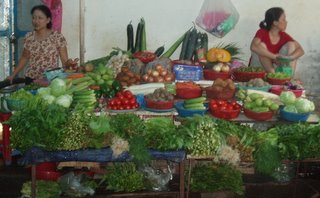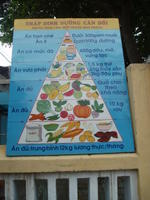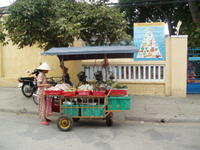 This vegetable stall is in Hanoi's December 19th market. The food is all fresh and beautifully arranged. The market is also housed indoors and a bit less rustic than the "Wet Market" in old town and much smaller and more manageable than the Central Market (which has many offerings other than food).
This vegetable stall is in Hanoi's December 19th market. The food is all fresh and beautifully arranged. The market is also housed indoors and a bit less rustic than the "Wet Market" in old town and much smaller and more manageable than the Central Market (which has many offerings other than food). These incredible vegetables show up in much of the food in Vietnam. Even the herbs that you sprinkle on your soup are some how more full tasting and delicious than the herbs we are used to, even here in California.
While I took lots of market and vegetable photos during my visit to Vietnam last summer, I kept forgetting to take a picture of lemon grass to illustrate my "faux" pho recipe. So here's just a food photo I like and a recipe I hope you'll enjoy.
Asian Noodle SoupAbout Eight Servings
This soup came about after my husband came back from his first trip to Vietnam. He asked me to cook “something” with lemon grass, a traditional Vietnamese flavor. I began to experiment with the citrusy, woody stalks, looking for a way to enjoy its fresh taste in a clean, vibrant, low-calorie way. A trip to the local produce store inspired this soup, which I nicknamed “faux pho,” after the Vietnamese noodle soup. Most pho soups are beef based, but my favorite was a lighter seafood and vegetable version. (If you can’t find lemon grass, add the extra lime juice, the soup is still wonderful.) Don’t forget to add the toppings to the individual bowls, they really make the dish special.
Soup Stock
· 4 cups low-sodium or homemade chicken stock or light vegetable broth
· 4 - 6 cups water (depending on how thin or thick you want your soup)
· Fresh ginger root, the size of a walnut, peeled and cut into thin slices
· 2 stalks of fresh lemon grass (do not substitute dried), trimmed with root end cut off, outer leaves peeled off and darker top stems discarded, leaving two approximately 8 - to - 10 inch stalks. Slice each stalk into half lengthwise creating four half stalks.
“Hard” Vegetables
· 1/4 cup chopped shallot or red onion
· 1 large red bell pepper, cut into ½ inch to ¾ inch dice
· 3 cups of chopped Asian (such as bok choy, baby bok choy, Napa cabbage) or green cabbage. (I used baby bok choy, saving the green leafy part for use later in the recipe and just using the white stalks for this part.)
· 8 to 12 fresh or reconstituted dried shitake mushrooms or 8-12 medium large white button mushrooms stemmed and cut into quarters. (I think the flavor and texture of the fresh shitake are really special in this soup. To use dried, soak in hot water for 30 minutes until soft.)
· 2 large carrots, cut into thin slices
Greens
· 3 cups of Asian greens or spinach leaves, chopped. (I used the tops of the baby bok choy here as well as pea sprouts, which look like miniature spinach leaves with a long thin stem. Produce and specialty markets have a variety of Asian greens such as pea sprouts and mizuna.)
Seasonings
· 4 tablespoons of Vietnamese or Thai fish sauce (sometimes labeled nam pla or nuoc mam), available in large supermarkets and specialty stores. If you don’t have it, see soy sauce.
· 2 tablespoons of soy sauce. If you are not using fish sauce, increase to 4 tablespoons
· Juice of ½ of a fresh lime. If you are not using lemon grass, increase to juice of a whole lime
· Fresh small hot red pepper (such as Thai, serrano or jalapeno), cut into thin rings, optional
The Noodles
1/2 pound of dried rice noodles
Look in the Asian or regular market for dried rice noodles about the width of fettuccine noodles (about ¼” wide). In Vietnamese they are called banh pho, but often they are packaged for Thai dishes as pad Thai noodles. If you can’t find rice noodles, fresh fettuccine is a good alternative. Cook before using.
Toppings
· Bean sprouts
· Chopped mixed herbs – basil, cilantro and mint (mandatory)
· Lime wedges
· Hot sauce, chili paste or other red pepper based sauce
· Hoisin sauce (optional – but I really enjoy it)
· Chopped green onions
Preparation
Combine soup stock ingredients and simmer for a half hour or until the mixture has picked up the lemon grass and ginger taste.
Add hard vegetables and simmer until almost soft. Add the greens and simmer two to five minutes until they begin to soften. Add seasonings, stir well and cook until greens are cooked through. Discard lemon grass stalks and ginger slices before serving.
Bring a large pot of water to a boil and put in the rice noodles. Cook for about five minutes and drain. Rinse in cold water.
To serve, add a portion of the noodles to the bowl before adding the hot soup, which will warm the noodles through. Ladle soup into bowl, top with a handful of bean sprouts and about ¼ cup of chopped mixed herbs. Pass the other toppings so every one can season to taste. A small spoonful of the hot chili paste or hoisin sauce will flavor a big bowl of soup, so add condiments a bit at a time.
Note: The chopped herbs are an important component to the taste of this soup and the bean sprouts add a very satisfying crunch. I urge you not to skip them.
Make it a Meal – Make it more substantial by trying one or both of these options.
1. Add small cubes of firm tofu after the hard veggies have been cooking a few minutes. Try about 4 to 6 ounces if using the shrimp below, or use 8 ounces if just using the tofu.
2. Add in some peeled, deveined shrimp. Add after the greens have simmered a minute or so. Simmer soup just until shrimp are pink and barely cooked through. The shrimp will continue cooking in the hot broth and will toughen if overcooked. Use about a half pound if using the tofu. If not, try a pound or so.







